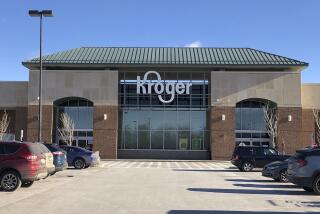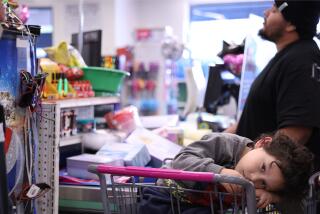Five years in, Fresh & Easy markets are a flop
- Share via
British supermarket giant Tesco thought it had the Yanks all figured out.
Determined to crack the U.S. market, it dispatched executives to live with American families, peek into their refrigerators and trail them on trips to the grocery store. It boasted of revolutionizing how Americans shopped.
But slightly more than five years after it opened its first Fresh & Easy Neighborhood Market in California, Tesco is considering selling the money-losing chain and leaving the United States altogether.
An email sent to shoppers recently acknowledged that the grocer doesn’t know “if Tesco will continue to own the company.” The 200-store operation in California, Arizona and Nevada represents an estimated $2-billion flop: a $1-billion investment on top of about $1 billion in cumulative annual losses.
“Tesco’s failure will rank as one of the biggest among food retailers in modern supermarket history,” said Burt Flickinger III, managing director at retail consulting firm Strategic Resource Group in New York.
With headquarters in El Segundo, Fresh & Easy touted itself as a European version of the Trader Joe’s chain, offering an assortment of groceries with an emphasis on fresh products to go. The plan was to slide into neighborhoods close to busy customers and win them over with convenience and tasty takeout meals. Stores were mobbed in the early days as curious customers rushed to check out the new kid in town.
But problems soon appeared.
Labor organizers targeted the non-union chain aggressively; shoppers often had to cross informational picket lines to get into the stores.
Fresh & Easy’s cost-saving business model of using only self-service checkout aisles was a hard sell with some customers who missed the ease of having checkers ring up their purchases.
Then, in 2011, the California Legislature threw a wrench into the works by requiring grocers to keep at least one aisle manned by a checker if alcohol was being sold. The legislation was designed, supporters said, to keep teens from buying alcohol and to preserve supermarket clerk jobs. But Fresh & Easy contended the law was intended to pressure the company into recognizing a union and signing a labor contract.
Industry watchers say Tesco also dug itself into a hole by sinking millions into an 850,000-square-foot distribution center in Riverside County, which put enormous pressure on the chain to quickly expand.
In addition, Tesco failed to customize merchandise by neighborhood, which is why its British stores are so popular. Fresh & Easy offered a limited variety of packaged goods, didn’t carry some well-known brands, was slow to restock popular items and often charged more for its private-label products than for name-brand counterparts, analysts said.
“They offered a uniform assortment in all their stores, meaning a store in upscale Scottsdale, Ariz., would have the same products as in Compton,” said Jim Prevor, an industry analyst who is editor of the food retailing website Perishable Pundit.
Fresh & Easy spokesman Brendan Wonnacott declined to comment beyond noting that the company was focused on “delivering a great shopping trip for our customers.” Tesco is still reviewing its American chain, he said, and will make an update in April as part of the company’s full-year results.
Many customers say Fresh & Easy promised a lot and delivered little.
“It really felt like aliens that crash-landed here in their Tesco-mobile and didn’t even look around to see what Americans liked,” said Gerry Carr, 51, of Venice.
Carr, a longtime vegetarian, said he was annoyed to find few salad options and little choice in herbal teas. Shoppers can’t inspect vegetables, or buy just one tomato or bell pepper, because produce is packed on trays and wrapped in cellophane. The self-checkout stands, which are common in Britain, also made him miss the human touch found at other supermarkets.
“They are teaching you their system, but you don’t want to learn their system,” said Carr, who shopped at Fresh & Easy several times before giving up on the chain.
Fresh & Easy underscores the pitfalls foreign companies with hefty muscles can face when trying to conquer the American market, analysts say. But it also highlights the folly of trying to capture market share by copying established chains such as the beloved Trader Joe’s.
“The two were clearly similar, and their stores are often located near each other,” Prevor said. “But there are only two concepts in the United States that are successful as small-format stores, and that is Trader Joe’s and its corporate cousin, which is Aldi.”
After checking out the first Fresh & Easy stores in Southern California, Joe Coulombe, the founder of the Trader Joe’s chain, concluded the British newcomer was doomed. Coulombe had heard that Fresh & Easy was trying to mimic the homey warmth of Trader Joe’s. What he saw, he said, was anything but.
“It did not resemble Trader Joe’s in any way,” recalled Coulombe, who in 1988 left the chain he envisioned as part gourmet purveyor and part discounter. The chain has a preternaturally friendly non-union workforce kept that way by generous pay and benefits. “I don’t think their management had any idea of what Trader Joe’s was all about.”
Coulombe said he was puzzled by how badly Tesco misjudged what the market wanted.
“Somehow their research got it all wrong,” said Coulombe, who no longer has any connection with the Trader’s Joe’s chain — it is owned by the Albrecht family in Germany, which also controls the discount grocery chain Aldi.
Tesco “spent two years doing market research, which I thought was admirable,” Coulombe said, “but it wasn’t translated into action.”
Ultimately, Fresh & Easy didn’t inspire much loyalty, although it did provoke some strong emotion in Frank Glaser, 79, of Rancho Palos Verdes.
After Fresh & Easy set up shop half a mile from his home, the retired aerospace executive said he worried that his normal neighborhood supermarkets would be hurt. So he and his friends launched an informal boycott of the new store.
“It’s like a small town, and at Trader Joe’s and also Ralphs, you meet your friends and you decide where to go to dinner together,” Glaser said. “I don’t know anybody that goes to Fresh & Easy.”
More to Read
Inside the business of entertainment
The Wide Shot brings you news, analysis and insights on everything from streaming wars to production — and what it all means for the future.
You may occasionally receive promotional content from the Los Angeles Times.











